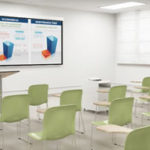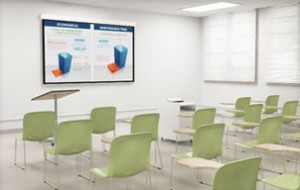
New design techniques that can heighten a projector’s contrast without sacrificing brightness, and eco-friendly projectors that eliminate the need for costly mercury lamps, are among the many recent developments in audio-visual (AV) technologies with implications for schools and colleges.
Here’s a look at these and other new trends in the AV market for education.
Educators trust projectors for medical imaging
Officials at the University of North Carolina School of Medicine’s Department of Radiation Oncology make critical treatment decisions based partly on images showing where cancer cells are, so having a crystal-clear projector image is critical for accurate diagnoses.
Julian Rosenman, a professor at the university’s Department of Radiation Oncology, said black-and-white CT scans with shades of gray dispersed throughout could dictate a patient’s treatment. That’s why the department bought two of Canon’s REALiS SX80 Mark II D Multimedia LCOS projectors, which are mounted on the ceiling for stability and offer dual projection images so students and doctors can compare and contrast scans side by side.
The Canon projectors also let Rosenman and his colleagues teleconference with medical professionals and students worldwide, because the projectors’ images can be shared with doctors at other campuses or hospitals.
“We do a lot of tumor boards and telemedicine meetings, in which doctors view medical images to make treatment decisions,” Rosenman said. “This is why the color accuracy of projected images is so important.”
The Canon REALiS SX80 Mark II D projectors feature 3,000 lumens of brightness and a pixel resolution of 1,400 x 1,050. They use a projection technology that Canon developed, called Liquid Crystal on Silicon (LCOS), to achieve ultra-sharp, high-contrast, lattice-free images without the “screen door” effect that can mute the color and detail of some LCD images.
Early LCOS projectors sacrificed compactness and brightness to achieve this degree of clarity, Canon says. But the company has developed a new optical system, called aspectual illumination system (AISYS), that solves this problem. AISYS splits beams of light into vertical and horizontal components, then uses each component to enhance brightness or contrast. The result is a system that combines the kind of sharp contrast and high degree of brightness needed to distinguish between many shades of gray.
The REALiS SX80 Mark II D features a mode that complies with Digital Imaging and Communications in Medicine (DICOM) devices, because it offers 21 levels of grayscale gradation for more accurate diagnoses. Having a DICOM feature built into the device, medical school officials say, means universities won’t have to buy costly additional equipment designed to supplement the image projectors.
UNC officials said the Canon projectors also have helped the medical school avoid image disturbances caused by other electronic devices in the area—a common problem among some projectors.
“Image stability is also very important when you are comparing medical data. I don’t know how Canon does it, but the [projectors] reject the jitter … caused by the other electrical equipment we’ve got going,” Roseman said. “With these REALiS projectors, you don’t see rolling bars or visible beat frequencies.
He added: “These are the smallest, quietest, and most stable projectors we’ve ever had. They also don’t throw off a lot of heat, which is important when you’ve got 20 people in the room.”
New ‘green’ projectors do away with mercury lamps
While the University of North Carolina relies on Canon’s accurate images, other schools and colleges are using Casio’s new lineup of Green Slim Projectors, eco-friendly projectors that eliminate the need for mercury lamps that typically must be replaced after 2,000 hours of use. Mercury can cause environmental damage if not disposed of properly.
The Green Slim DLP projectors use a patented hybrid “solid state” light source, which combines laser and LED technology to achieve high brightness, instead of a mercury lamp.
The green projectors—designed to last 20,000 hours, or about 18 school years—will save schools and colleges money while operating budgets stagnate during the current economic downturn. A typical projector lamp replacement costs $400, meaning schools could spend thousands of dollars in new lamps over the life of a projector. Traditional projector lamps are also known to dull over time.
Not all lamps burn out after a few thousand hours, however. Sony in April unveiled two new project models, the VPL-FX500L and the VPL-FX30, that exceed industry standards. The VPL-FX500L model, according to Sony’s web site, has a lamp life of 8,000 hours if the dual lamps are used equally.
Casio’s Green Slim Projectors, complete with 2X zoom lens and a USB outlet for users to plug their laptops in to give class presentations, are only 1.7 inches thick, making them among the market’s most portable projectors. They range in price from $800 for an XGA (1,024 x 768) projector with 2,000 lumens but no wireless connectivity to $1,100 for a WXGA (1,280 x 800) projector with 2,500 lumens and wireless capability.
Web site identifies most popular projectors in education
A recently survey conducted by ProjectorCentral.com, a web site that monitors projector trends, revealed the 10 most popular projectors among educators this year. Epson’s PowerLite S7 topped the list, while Hitachi’s CP-X2510 projector ranked second and Epson’s PowerLite 410W ranked third. Epson had four projectors in the survey’s top 10 results.
More than 1,100 ProjectorCentral.com visitors were included in the survey, with 407 voting for projectors that made the top 10 list, said David Dicklish, the web site’s publisher. Fifteen other projectors received votes, he said.
A common characteristic among the top finishers is that they seem to have hit the “sweet spot” in combining image quality and affordability.
The Epson PowerLite S7, for instance, features 2,300 lumens, a 2,000-to-1 contrast ratio, SVGA (800 x 600) resolution, built-in closed captioning, USB plug-and-play, and an energy-efficient lamp (for extended life up to 4,000 hours) for around $500. The Hitachi CP-X2510 costs around $700, features XGA resolution, and uses a 6,000-hour eco-mode lamp and a filter design that only requires maintenance every 5,000 hours.
“The CP-X2510 lacks a digital input and network capability and has a relatively large case size,” wrote ProjectorCentral in its review of the device. “But it nicely balances performance and value and is well worth consideration for office, classroom, or any presentation use where light weight or extreme portability are not of greatest concern.”
Dicklish said high-end projectors have become preferable to LED displays, which can cost several times the cost of a projector.
“You can assume that anybody who has content that they needed to see bigger and in more detail has gone to that kind of technology,” he said of projectors like the Canon REALiS model. “It has a lot of application.”
Elizabeth Dourely, an expert on projectors for education and a contributor to ProjectorCentral.com, said the Epson BrightLink 450Wi is “one of the most buzzworthy projectors” in education today. The 2,500-lumen device includes built-in software that eliminates the need for a separate interactive whiteboard. It can project images onto any whiteboard, wall, or smooth surface, and it comes with two digital infrared pens that let teachers and professors mark images and highlight specific areas.
“We would certainly consider this projector a game-changer,” said Claudine Wolas, project manager for Epson Electronics’ BrightLink 450Wi. “It’s not just the newest and latest in projectors, but in whiteboards as well.”
Educators said the BrightLink maintains stability even when a nearby air conditioning unit turns on. Many classroom projectors shake from close-range vibration, they said.
In its Classroom Projector Resource Center, ProjectorCentral also features “Problem-Solving Projectors Under $1,000.” These include the Sanyo PLC-XW300, which features XGA resolution and a Blackboard Mode (“Who needs a screen?” writes the web site); the NEC NP510W, a networkable projector with WXGA (wide XGA) resolution that is ideal for classrooms with one-to-one laptop programs, allowing any student to project an image from his or her own machine; and the BenQ W1000, a quiet projector with 2,000-plus lumens running under 30 decibels.
Sound systems incorporate iPods, amplify presentations
Projector companies are also addressing sound system issues in the classroom and lecture hall with devices that attach to projectors. Epson’s AP-60 Sound Enhancement System, for example, can be installed on ceiling-mounted projectors. The device amplifies sounds coming from the projector with four interconnected speakers and directs the sound toward the audience.
The AP-60 also comes with an infrared pendant microphone for educators and students speaking to a large classroom or lecture hall. The Epson device can connect to almost all projectors’ standard mounting equipment, making the enhancement system ideal for school officials looking for retrofit their classroom technology without spending a fortune on brand-new equipment.
As iPods have become ubiquitous among teenagers and young adults, an Illinois-based company called AmpliVox Sound Systems has found a way to incorporate the popular MP3 player into classroom use.
AmpliVox’s IPOD PA System, which is compatible with almost every iPod model and the iPhone, has a docking station for the Apple devices and is designed to amplify the iPod’s sound. The 30-watt machine is used at about 3,000 schools and college campuses nationwide and is made for audiences of up to 500 people, making it usable for even the largest college lecture halls and rooms of up to 2,500 square feet.
The IPOD PA System, which hit the market six months ago, also features a DVD/CD player, a USB outlet, a wireless microphone, and four-hour rechargeable batteries.
“The only way to describe the iPod phenomenon is ubiquitous,” said Don Ross, CEO of AmpliVox, adding that the IPOD PA System recharges iPods and iPhones when they are plugged into the machine’s docking area. “It’s really become a way … for students to incorporate technology in their homework and class presentations and a whole range of [other assignments] that they get from their teachers and professors. … We’re happy to help [students] find new ways to incorporate their iPods in their education.”
- Lawmakers to colleges: No more social media prying - April 25, 2013
- Number of college applications affected by social media triples - October 9, 2012
- Gates Foundation supports college readiness apps - September 28, 2012


